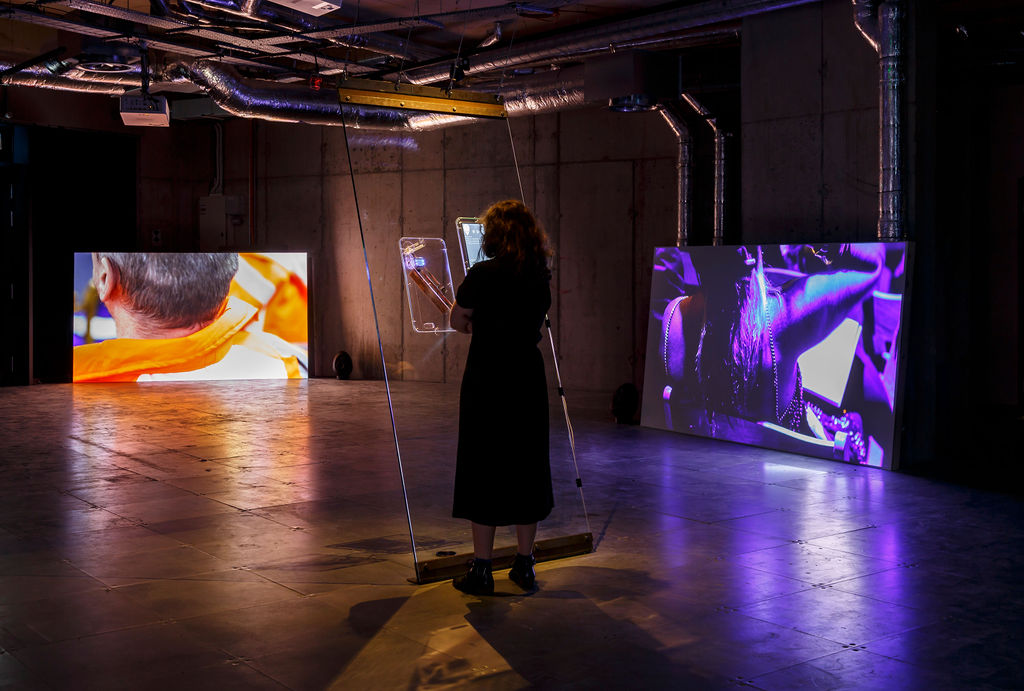


Trickle Down, A New Vertical Sovereignty installation view. Photograph by David Oates
Depending on who you ask, blockchain is either the future of money or an overhyped phenomenon. Blockchain is behind cryptocurrencies like Bitcoin and Ether, a decentralised and immutable ledger of transactions. The utopian sentiment surrounding cryptocurrencies predicts they will cut out banks and governments, relying on encryption and decentralisation to do away with the need to trust in institutions or individuals. It is yet to be seen whether the technology will come into wider use, but if it does will it bring reform or further entrench existing inequalities? These are the concerns of Helen Knowles’s installation Trickle Down, A New Vertical Sovereignty (2020) at Arebyte Gallery.
To view the installation, you must insert a pound coin into a panel in the middle of the room. The coin starts a four-screen video installation and soundscape that grapples with cryptocurrency, wealth inequality and systems of value.
Knowles was interested in the way she and other artists often exist in a world of economic insecurity but also have access to the wealthy spheres of the art world. Her interest in this wealth disparity led her to documenting wealthy Russians at a Sotheby’s auction. She began to document other auctions including a bric-a-brac market in North Manchester, and by photographing the attendees’ clothing she makes the economic disparity between these communities materially visible. Knowles recognised auctions as a site where financial transactions are made explicitly public, like with the blockchain, and the exchange of wealth can be witnessed.
While her previous work is interested in the implications of technology this was her first foray into incorporating it in her work through the coin panel. The effect of watching the coin roll into the machine and the flashing coloured lights mimics the dopamine hit of a slot machine or a futuristic wishing well. It also toys with the idea of the retro and the futuristic, requiring a physical coin rather than the tap of a card.
The coins collected in the machine are converted into the cryptocurrency Ether and distributed between the people who contributed to the project via a smart contract on the blockchain. The machine also holds a screen that displays these transactions occurring on the blockchain ledger. The machine makes the invisible visible, from the digital transactions to the mechanisms of the coin slot itself where the hardware and components can be seen through a glass panel. The work functions on the basis of transparency and proposes a vision for a financial system that does the same.
As part of the project, Knowles staged an auction in a prison to explore alternative economies and value systems. Since the prisoners were financially limited due to their incarceration they decided to bid with their labour. The prisoners wanted to keep plants in their cells but were not allowed to, so they chose to auction plants that were then sent to their families for Christmas.
The distribution of money from the project is reliant on the participants supplying Knowles with an Ethereum wallet in order to receive the micropayments. Only two of the prisoners involved in the project sent Knowles their wallets, revealing the barriers of education and access in participation in the blockchain. While proponents of the blockchain predict a revolution, the scales have not quite tipped. This technology is still largely in the hands of those with the knowledge and access to benefit from it. As Knowles’s work highlights, the question still remains as to whether this technology will be a leveller or simply uphold structures of wealth disparity.
Helen Knowles (b. 1975) is the curator of the Birth Rites Collection. Recent shows include; Trickle Down: A New Vertical Sovereignty at Arebyte Gallery, Poplar (2020); Future and the Arts: AI, Robotics, Cities, Life - How Humanity Will Live Tomorrow at The Mori Art Museum, Tokyo (2019); and Artistic intelligence at Hannover Kunstverein (2019).